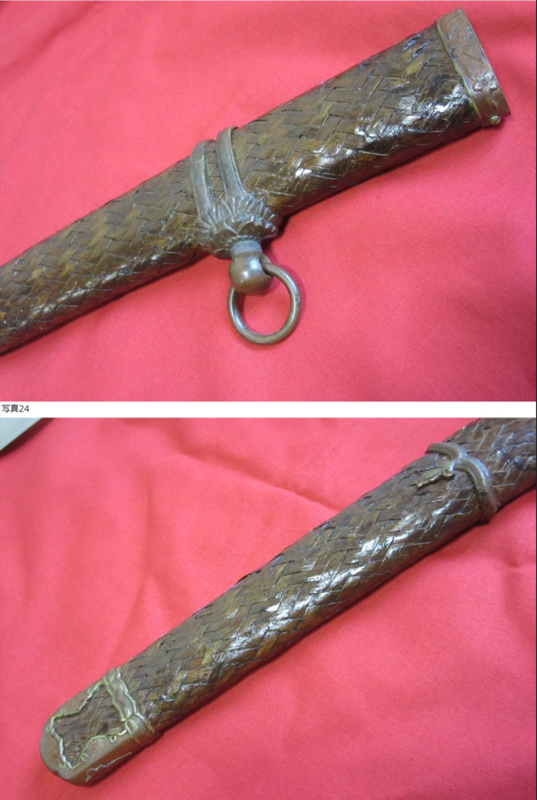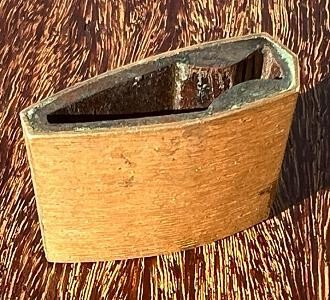-
Posts
13,932 -
Joined
-
Last visited
-
Days Won
169
Content Type
Profiles
Forums
Events
Store
Downloads
Gallery
Everything posted by Bruce Pennington
-

Wakizashi tameshigiri edo
Bruce Pennington replied to Hiro nakamura's topic in Translation Assistance
The real experts will fill in the rest, but this last photo is the cut test mei of Hisahide, December 1665. On a personal note, I never realized they did cut tests on waki. And as an FWIW, this is the earliest cut tested blade I have of his on file. -
Like John says, we could use some photos of the blade - is there writing on it? - and the nakago (tang). At best, it is something made in the occupied territories. Photos will help.
-
Trystan, You caused me to go back to the Wehrmacht-awards thread, and sure enough, he stated the 3 photos were of "naval landing forces." So it was a Type 97. I can see a sarute in the navy kabutogane.
-
Thanks, Uwe. It is a bit odd. With all that corrosion, I'm surprised the mei is there at all, and I'm tempted to think it was added later by an unskilled hand.
-

Shin gunto with rattan saya exterior
Bruce Pennington replied to Gerry's topic in Military Swords of Japan
You were close. Guy's answer: "予士 [Yoka] 「陸軍士官学校 (日本)」の記事における「「陸士」・ 「予士」・「航士」」の解説 陸軍予科士官学校 Rikugun Yoka Shikan Gakko Army Officer Preparatory School Quick machine translation: Explanation of "Army Cadet," "Preparatory School," and "Navigation Officer" in the article "Army Academy (Japan)" For details, see "Army Preparatory School" and "Army Aviation Academy." From the dawn of the Imperial Japanese Army until its dissolution, the organization underwent several transformations. However, the educational system remained two-tiered, consisting of a main course and a preparatory course, as in the old system, with clearly distinct educational content (#Curriculum). In 1937 (Showa 12), ..... [etc] 「陸軍士官学校 (日本)」の記事における「「陸士」・ 「予士」・「航士」」の解説 詳細は「陸軍予科士官学校」および� �陸軍航空士官学校」を参照 帝国陸軍の黎明期からその解体まで� �織には幾度の変容があるが、教育段� ��は旧制学校と同様に本科と予科の二 層立てであり、教育内容も明確に異� �る(#教育課程)。1937年(昭和12年) には人員増加等を理由に、予科は「� �軍予科士官学校」と分離独立した学� ��となった。同時期、現役航空兵科将 校(陸軍航空部隊向けの航空要員た� �現役兵科将校)の教育に特化させた� ��科として、「陸軍航空士官学校(当 初は「陸軍士官学校分校」)も分離� �立している。これらはそれぞれ「陸� ��」・「予士」・「航士」などと略称 された(#歴史)。........" -
Hey guys, Can I get one of you magicians to read this one for me, please? It's on a nice, upgraded navy dirk:
-

Increasing Gold Membership numbers?
Bruce Pennington replied to Brian's topic in General Nihonto Related Discussion
Yes, and it's how I get a ton of stuff for my charts, too! Ha! But I understand what you guys are getting at. I don't mind the posts, as my hobby has morphed into just being here to help new guys with their questions. If we don't allow that, we just become an insular bubble of old farts incestuously wallowing in our own stuff. It's like having a "City name" Japanese Sword Club that only allows people to show up if they join first. But I totally get Brian's problem with growing data needs and less than matching memberships/donations. Tough problem, for sure. NMB is like a public library where people can go to look up stuff and learn, yet needing the financial support to keep it open. It is a struggle all non-profits and not-for-profits constantly deal with. -
I know that shadowing and the fact that it's a black & white photo could be falsely giving the impression, but this could be a black painted saya. It's clearly a Type 95, steel tsuba (sorry Sam, no numbers, Ha!):
-
-
-

Shin gunto with rattan saya exterior
Bruce Pennington replied to Gerry's topic in Military Swords of Japan
Thanks, Steve! I posted it over on Warrelics to run it by Guy and Akira to confirm. Will update when they reply. -

Shin gunto with rattan saya exterior
Bruce Pennington replied to Gerry's topic in Military Swords of Japan
@SteveM Steve, can you translate the mei on this for us? I have 3 on file with chiseled/etched numbers, but all 3 used Japanese numbers. I feel like I've seen one with western numbers, but I don't have record of it. Two of them are Type 95s and one is a Type 98. 98 95s - both were coppers Thanks for the link on the ratan cover, Joseph! @IJASWORDS said he's seen a few of these, and they were had Katsumasa blades. -

Nihonto? Japanese Naval sword for sale
Bruce Pennington replied to Jan Pirecki's topic in General Nihonto Related Discussion
Thanks for sharing this, Jan. Both the blade and the fittings are quite beautiful. Those fittings were an upgrade, and for us Military sword collectors, quite desirable. A small clarification - "Kyu gunto" were the early, Western-styled sabers. This is a navy "kaigunto" (Kai - navy; gunto - literally army sword, but it was used more commonly as "military sword"). -

World War II Sword, Maybe?
Bruce Pennington replied to garbage finds's topic in General Nihonto Related Discussion
Generally speaking, moisture is the enemy of steel blades. Order a nice sword cleaning kit - Online List of Japanese Sword Cleaning Kits - and use the oil that comes with it to with all the parts down, especially the blade. -

World War II Sword, Maybe?
Bruce Pennington replied to garbage finds's topic in General Nihonto Related Discussion
Value runs from $1,600 to $2,400 depending upon condition, this one in the lower half of the range. But that still depends upon where and when you sell it. -

Military Swords forum subtitle
Bruce Pennington replied to John C's topic in Forum Technical Details and Maintenance
The star is confirmation that the army provided the steel for the blade. The only steel the army provided to RJT Smith’s was tamahagane. I cannot imagine a smith using tamahagane and oil quenching the blade. Now, on the other hand, you can have a blade made by an RJT qualified smith, but it may be made from a different kind of steel and either water or oil quenched. That is something that each blade of this type would have to be evaluated. -
Agreed - Showa 20 - 1945; March. Brian, is that a stamp above the date? Are there stamps above the mei?
-
Wow, gorgeous!
-
I have this blade on file from @phil reid, back in 2021, as "1940". Looking at his other blades, the date kanji line up well for that year. Such a gunto, in today's market, rans more like $1,200-1,400 USD, which is about 2,000 Aus dollars.
-

For anyone collecting WW2 polisher mei
Bruce Pennington replied to John C's topic in Military Swords of Japan
Wow, never seen this before! -
Tom, Is this yours? If so, are there small stamps on the nakago mune (back edge)? You know about the RJT star-stamped blades, right? Could we get a couple shots of the hamon and fittings?
-

Scam site selling a blade I own
Bruce Pennington replied to John C's topic in Auctions and Online Sales or Sellers
Wow. Are the photos from a sale page from whom you bought it? -
Thanks, Paul! Looks like it was part of the stamping practice of the Shōheikan Military Uniform Co., Ltd, then. Might be able to move this small star out of the "Unknown" category. I'll have to do some digging first to see if seen only/always on Shōheikan fittings.
-
Not my forte, but thought you guys might appreciate this. Made by 菊岡 Kikuoka I thought it was interesting to see a habaki designed with the inner lining fitted to the bohi. Also, his method for attaching his name to the back of the menugi seemed unique.
-
I have my first opportunity to attend a sword club meeting, this one in Sacramento. It will be Tuesday, 18 Nov, at 7pm. Meeting is at the Sacramento Asian Community Center; 7334 Park City Dr., Sacramento CA 95831. Hope to see somebody there from NMB, but I don't know if we have anyone else here.
- 1 reply
-
- 4
-

-


















